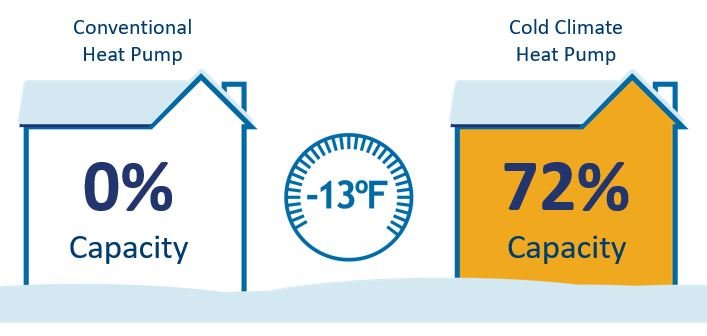HOMEOWNER RESOURCES
Cold climate heat pumps
While the heat pumps of even just 10 years ago struggled at the coldest temperatures, today, every major manufacturer offers “extended capacity,” or cold-climate, heat pumps.
In fact, cold-climate systems are able to provide at least 85% of their heating “oomph” at temperatures as cold as 5° F., and some work at temperatures as low as negative 15° F.
How are cold climate heat pumps different from normal heat pumps?
Traditional heat pumps cannot perform at very low temperatures and therefore require supplemental heat, while cold climate heat pumps require less supplemental heat.
All heat pumps operate by transferring heat, moving heat from outside to inside in the winter and reversing in the summer. However, cold climate heat pumps are designed to optimize their performance when operating in cold climates for increased comfort and energy efficient operation.
Technically speaking, cold climate heat pumps adjust the compressor speed and expansion valve settings leading to the right refrigerant pressure at the outdoor unit to still collect outdoor heat, even at extremely cold outdoor temperatures. Compared to conventional equipment, cold climate heat pumps usually have larger indoor and outdoor coils.
Heat Pump manufacturers have various trade-marked names associated with their products to describe their enhanced performance equipment in comparison to “standard” Heat Pumps.
When should you consider a cold climate heat pump?
If you live in a cold climate, such as climate zone 5 or 6 (green and blue), a cold climate heat pump or a hybrid system will be good options. We would recommend a hybrid system for climate zone 7 (purple) and above. In climate zones 1-4 (pink, red, brown and yellow), with proper sizing, a cold climate heat pump is generally unnecessary.
Let’s take Seattle, WA (climate zone 4) as an example. We know from weather data that 99% of temperatures throughout the year will be above 28°F, and your heat pump system will be designed to comfortably meet your necessary heating needs at this “design temperature”. A standard heat pump that provides 80% of rated heating capacity at 28°F can easily be sized to meet your needs, and backup heat strips can supplement the heat pump on those 1% days when the temperature drops further. Since cold climate heat pumps are more expensive than standard models, this would be a more cost effective solution in Seattle.
On the other hand, if you live in Spokane, WA (climate zone 5), your 99% “design temperature” will be 10°F. At this temperature, a standard heat pump would operate at less than half of its rated capacity, meaning a standalone standard heat pump would need to be hugely oversized. On the other hand, a cold climate heat pump would be able to meet the design requirements, continuing to operate at 100% capacity at 5°F. Here, we would recommend a cold climate model.
HOMEOWNER RESOURCES
EDEN Home Basics
Heat pumps vs. ACs: What's the difference?
If you are considering a system to cool your home, both heat pumps and air conditioners will do the job. However, a heat pump will also provide highly efficient heating during the winter as well.
What is a heat pump and why should I upgrade?
A heat pump provides all-in-one heating and cooling for perfect year-round comfort. Not only that, it operates more than 3x efficiently compared with a standard furnace.
Heat pumps vs. furnaces: What’s the difference?
Heat pumps and furnaces heat your home – but in different ways. The most significant difference between furnaces and heat pumps is that furnaces create their own heat.


